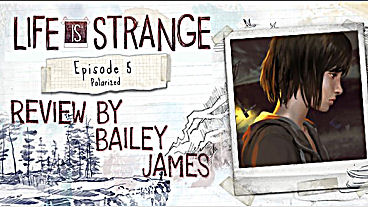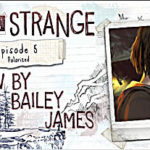
Life is Strange Episode 5: Polarized – Review
Weeks after the final episode dropped I’m still dwelling on these characters







Genre: Point-And-Click Adventure
Release date: October 20, 2015
After many, many months of waiting, the end of Life is Strange has finally come. Weeks of agonizing over past choices and anxiously hoping that the conclusion would live up to my sky-high expectations were finally quelled with the release of Polarized, the fifth and final episode in the series. That’s what I thought would happen, anyway. Something like freedom, or relief.
But weeks after the final episode dropped I’m still dwelling on these characters, thinking about what happened and wondering if Max will be okay. Life is Strange tells a story so magnetic and unflinching that I know it won’t let me go for a long time.
If you haven’t played this game yet, turn back now and treat yourself to something truly special. If I haven’t convinced you by now that it’s worth your time, I don’t know what will. But I’ll be going into everything that happens in the final episode, so spoilers abound from here on out.
When we last left Max, she had been drugged by Mr. Jefferson after seeing Chloe get shot in the head. It was a dark cliffhanger that left no uncertainty as to the danger Max was in, and when Polarized opens with Max bound to a chair in her photography teacher’s underground darkroom it’s obvious that she still has much to endure before she’s in the clear. Photographs enable her to use her powers to travel to different stages of a drugged-up photo shoot, but even then she’s not in control. The camera is all over the place and tilting wildly as Jefferson takes his shots, and Max has no autonomy over the perspective of the scene nor are we as players able to take control of Max. It’s a frustrating but effective way to convey her powerlessness.
The unveiling of Mark Jefferson’s madness and his involvement in the disappearance of Rachel Amber are the weakest elements of the game’s overarching story. The character lapses into a familiar “twisted artist” script that feels so overblown and aggressive that it’s out of place even in a world that contains time travel and storms of biblical proportion. Jefferson spends so much time screaming that he doesn’t even sound like the same person he was at the beginning.
The structure of this episode takes the form of a journey through different facets of Max’s psyche and the ways in which it has been stretched to the point of snapping in the course of one mindbending week. Her first stop in a parallel timeline brings her to San Francisco, where she is being honored as a winner of the Everyday Heroes photo contest. The whole sequence at the Zeitgeist Gallery, warmly lit and optimistic, feels like an idealized ending, what a fan would have written if asked to invent the best possible way for Max to fix the timeline. It’s a beautiful scene, a delicious example of how Dontnod drizzles lush detail over every character and setting, all in service of creating a fully realized gallery show that many players will speed past without even glancing at. But there’s also the persistent feeling, as Max inspects other artists’ photographs of commonplace greatness and slowly makes her way toward her own selfie, that it isn’t real. She’s seen too much and meddled too thoroughly for the world to feel this shiny.
And then there’s the storm. It’s been brewing since the start of the story and has come to represent more than the destruction of the town. It’s an amalgam of every ounce of guilt and anxiety that Max feels about changing the past, manipulating the people around her and rooting around for the perfectly sculpted outcomes of every interaction. And when it arrives, the only person who can throw a protective shroud over her classmates and friends is Max. She gets one last noble chance to use her powers and to push through the darkness that envelops her to escape with some small piece of goodness intact.
And it’s Warren we say goodbye to when we leave the shattered world behind — one last conversation with our man of science, our window into a reasonable, comprehensible world. We’re going to a place where logic and sense don’t exist and never really mattered anyway.
The swirling torrent of memory fragments and distorted impressions that comes next is the best argument for why this episode is challenging, both to classify and to play. It’s like a series of magic tricks: Max will find herself in a familiar but twisted landscape, fumbling to understand and thus to tame the perversion in the scene. Max’s familiar dormitory hallway is papered in missing posters featuring Rachel Amber’s face until you find Max’s door. She finds herself trapped in a snow globe spectating on an old memory she could never put right. She’s trapped in a stealth sequence (an infuriating one, at that) and must avoid all the menacing men who have harassed her and impeded her goals over the course of the story. Playing these parts isn’t enjoyable — it’s disorienting and disjointed and you don’t know what’s coming next — but they reveal the knots and pitfalls of her subconscious. The deeply repressed worries, the memories worn smooth by obsessive mental replay, the anxiety and self-consciousness, the feeling of being useless — every parasitic thought that plagues the mind of a teenage girl. It’s all here swirling around Max, culminating in a scene where she confronts a meaner, more cynical version of herself who accuses her of abusing her powers to be liked. It’s so sad but so believable.
I knew it was bound to be coming, but I still wasn’t prepared to make the final choice. And it was a doozy: either you sacrifice Chloe to save the town and all its inhabitants from the hurricane, altering time once more to let her die, or you let the storm run its course and escape with Chloe, never looking back on the wreckage of your former home. More analytical players probably could have called this one, but I was too entrapped in the thick weave of the story to realize that all the game’s emotional moments were building to this test.
I had two problems with this ending when I first completed it, one of which remains and one of which has dissolved over time. The first is that the gamemakers cannot conceal their belief that one of these branches is the “right” answer. If you choose to let Chloe live, the two of you drive through the town’s wreckage toward an uncertain future in a startlingly short segment that feels reluctant to pursue its own possibilities. The biggest tell of all is that this ending is scored by Syd Matters’ “Obstacles,” a track already used to punctuate the first episode. In a series so adept at nailing mood and making use of its music, the recycled song feels like a snub. More than anything, it feels chiding, as if saying, “hasn’t this experience taught you anything?”
But if you sacrifice Chloe to save everything and everyone else that the game has imbued with meaning, the ending you get feels rich and fleshed-out. Chloe dies on the bathroom floor where you first saw her shot and time unwinds itself, erasing everything and making it clean and whole again. There is a long funeral sequence, a new song, grief that shows promise of abating one day. It’s tender and sad, just what you’d want for a send-off for a girl like Chloe, but it’s frustrating that this ending gives short shrift to the other option. In my playthrough, after much trepidation and anxiety, I chose to sacrifice Chloe; but to save her and leave town is just as legitimate a choice. It’s not impossible to imagine that after everything Max has seen, she’d prefer Arcadia Bay wiped off the map compared to the heartbreak of losing the person she loves the most. She would probably feel guilty about it every day for the rest of her life, but it should have felt more like a real outcome.
My second complaint about the ending was that if you pick the “good ending” where life returns to normal, sans Chloe, every choice you’ve made in the entire game is irrelevant. Every time Max befriended a classmate or kissed someone or abused her abilities to get ahead had vanished, the rough edges sanded down into a smooth, seamless surface. But the more I thought about it, the more I realized that isn’t true. The world has been wiped clean of everything that’s happened, but Max hasn’t. She has personally witnessed acts of violence, been abducted and drugged, had to choose who to save and who to let die; but now, she has no one to share these experiences with. Chloe, her greatest confidante, is gone, and who else would believe what happened? This ending, more than anything else, explains why Max used a picture of herself to win a contest about “Everyday Heroes.”
Much like one’s own teenage years, this game is more meaningful with distance and retrospection. Many people won’t like it. Many people won’t want to keep thinking about it after they’ve finished the last chapter. But Life is Strange — though flawed in many ways — is nonetheless important. It’s bold and specific and visionary and challenging. It’s a story about a girl who, despite possessing time-reversing powers, is remarkably ordinary in her worries, anxieties, and dreams. I haven’t seen anything quite like it before, and it’s one of the best games I’ve played. Max will stay with me a long time, and I know that one day, far in the future, she’ll be okay. There will be music again.
|
+ Detailed and exquisite scenes
+ A potent resolution to the relationship between Max and Chloe
– Mark Jefferson’s cliché turn
– Frustrating dream sequences, especially the stealth sequence
– Endings don’t feel equally weighty
|
 |
Processor: Dual Core 2.0 GHz or equivalent
Memory: 2 GB RAM
Graphics: ATI or NVidia card w/512 MB RAM (not recommended for Intel HD Graphics cards)
Hard Drive: 3 GB available space

Leave a Reply